Sociological Analysis of Poor Care and Conditions in NZ Health Homes
VerifiedAdded on 2022/12/29
|5
|1797
|54
Report
AI Summary
This report examines the issue of poor care in New Zealand health homes, focusing on factors such as increasing elderly population, staffing shortages, and outdated standards. The report highlights the concerning trend of inadequate care, leading to adverse incidents and even deaths. It emphasizes the need for mandatory staff-to-patient ratios and improved government oversight due to the increasing demand for aged care facilities and the financial pressures faced by these institutions. The lack of transparency and accountability in the sector is also discussed, calling for government intervention to address loopholes and develop new regulations to ensure better care standards. While some facilities maintain high standards, many struggle with outdated practices and insufficient resources, necessitating a comprehensive overhaul of the industry.
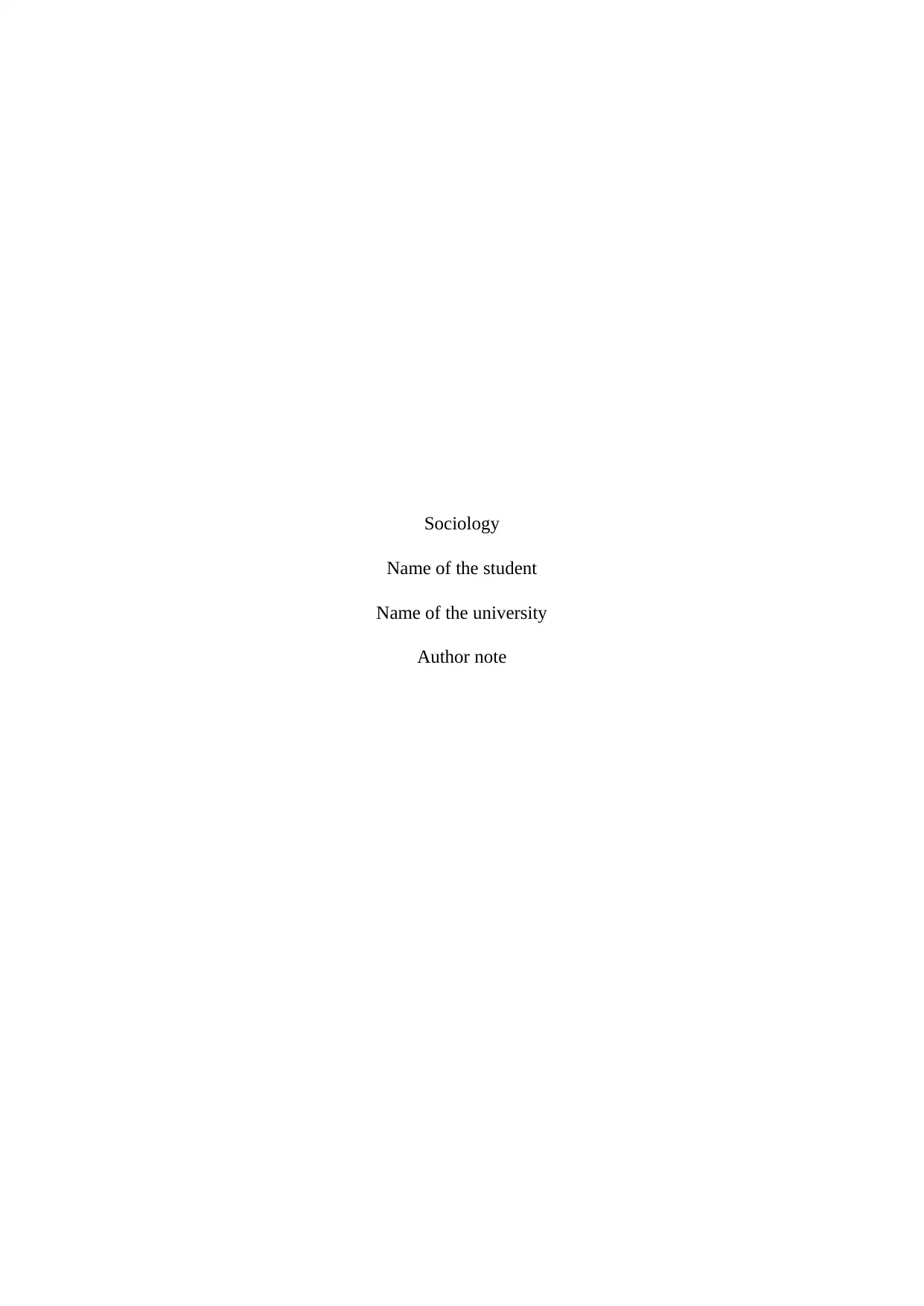
Sociology
Name of the student
Name of the university
Author note
Name of the student
Name of the university
Author note
Paraphrase This Document
Need a fresh take? Get an instant paraphrase of this document with our AI Paraphraser
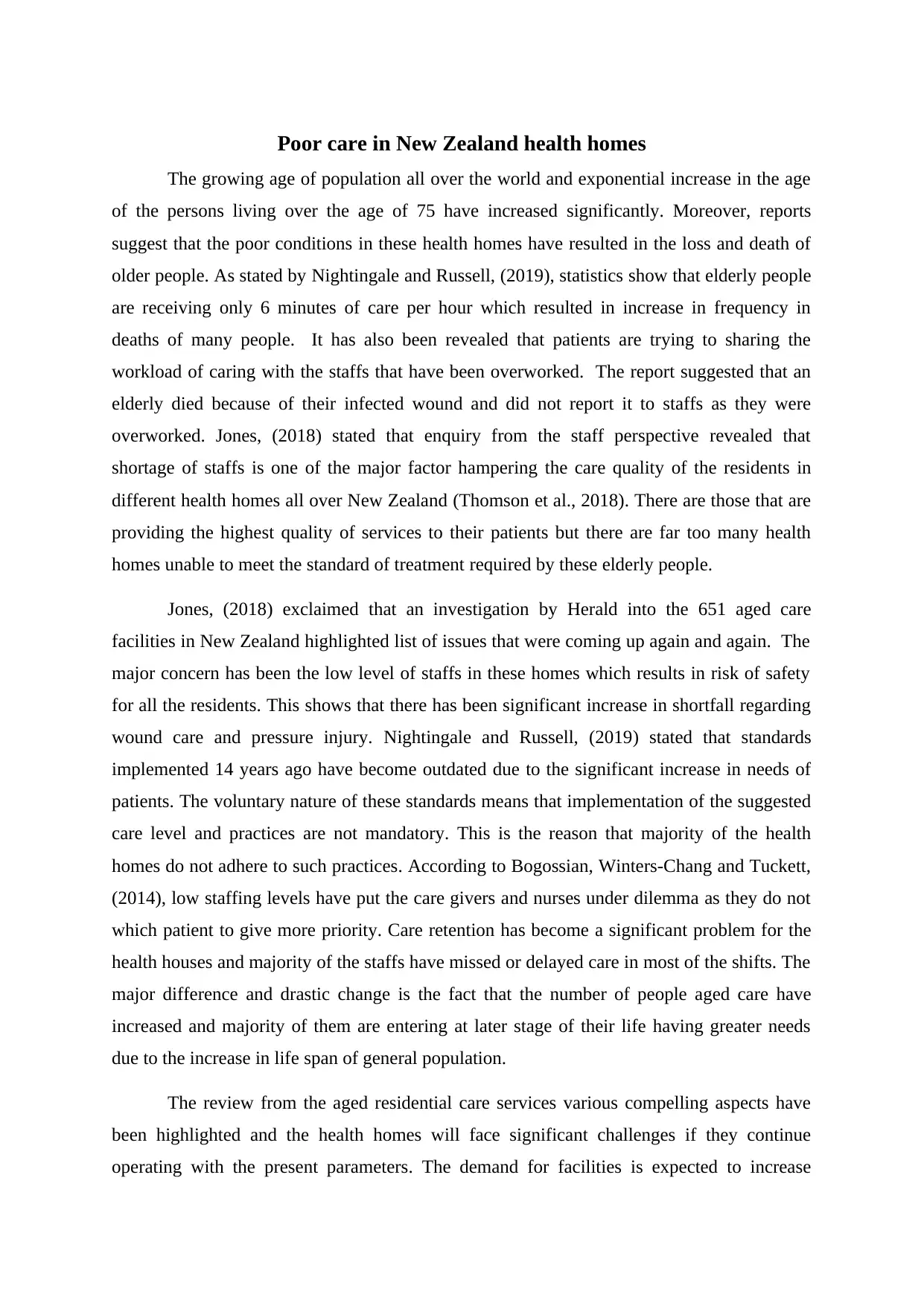
Poor care in New Zealand health homes
The growing age of population all over the world and exponential increase in the age
of the persons living over the age of 75 have increased significantly. Moreover, reports
suggest that the poor conditions in these health homes have resulted in the loss and death of
older people. As stated by Nightingale and Russell, (2019), statistics show that elderly people
are receiving only 6 minutes of care per hour which resulted in increase in frequency in
deaths of many people. It has also been revealed that patients are trying to sharing the
workload of caring with the staffs that have been overworked. The report suggested that an
elderly died because of their infected wound and did not report it to staffs as they were
overworked. Jones, (2018) stated that enquiry from the staff perspective revealed that
shortage of staffs is one of the major factor hampering the care quality of the residents in
different health homes all over New Zealand (Thomson et al., 2018). There are those that are
providing the highest quality of services to their patients but there are far too many health
homes unable to meet the standard of treatment required by these elderly people.
Jones, (2018) exclaimed that an investigation by Herald into the 651 aged care
facilities in New Zealand highlighted list of issues that were coming up again and again. The
major concern has been the low level of staffs in these homes which results in risk of safety
for all the residents. This shows that there has been significant increase in shortfall regarding
wound care and pressure injury. Nightingale and Russell, (2019) stated that standards
implemented 14 years ago have become outdated due to the significant increase in needs of
patients. The voluntary nature of these standards means that implementation of the suggested
care level and practices are not mandatory. This is the reason that majority of the health
homes do not adhere to such practices. According to Bogossian, Winters‐Chang and Tuckett,
(2014), low staffing levels have put the care givers and nurses under dilemma as they do not
which patient to give more priority. Care retention has become a significant problem for the
health houses and majority of the staffs have missed or delayed care in most of the shifts. The
major difference and drastic change is the fact that the number of people aged care have
increased and majority of them are entering at later stage of their life having greater needs
due to the increase in life span of general population.
The review from the aged residential care services various compelling aspects have
been highlighted and the health homes will face significant challenges if they continue
operating with the present parameters. The demand for facilities is expected to increase
The growing age of population all over the world and exponential increase in the age
of the persons living over the age of 75 have increased significantly. Moreover, reports
suggest that the poor conditions in these health homes have resulted in the loss and death of
older people. As stated by Nightingale and Russell, (2019), statistics show that elderly people
are receiving only 6 minutes of care per hour which resulted in increase in frequency in
deaths of many people. It has also been revealed that patients are trying to sharing the
workload of caring with the staffs that have been overworked. The report suggested that an
elderly died because of their infected wound and did not report it to staffs as they were
overworked. Jones, (2018) stated that enquiry from the staff perspective revealed that
shortage of staffs is one of the major factor hampering the care quality of the residents in
different health homes all over New Zealand (Thomson et al., 2018). There are those that are
providing the highest quality of services to their patients but there are far too many health
homes unable to meet the standard of treatment required by these elderly people.
Jones, (2018) exclaimed that an investigation by Herald into the 651 aged care
facilities in New Zealand highlighted list of issues that were coming up again and again. The
major concern has been the low level of staffs in these homes which results in risk of safety
for all the residents. This shows that there has been significant increase in shortfall regarding
wound care and pressure injury. Nightingale and Russell, (2019) stated that standards
implemented 14 years ago have become outdated due to the significant increase in needs of
patients. The voluntary nature of these standards means that implementation of the suggested
care level and practices are not mandatory. This is the reason that majority of the health
homes do not adhere to such practices. According to Bogossian, Winters‐Chang and Tuckett,
(2014), low staffing levels have put the care givers and nurses under dilemma as they do not
which patient to give more priority. Care retention has become a significant problem for the
health houses and majority of the staffs have missed or delayed care in most of the shifts. The
major difference and drastic change is the fact that the number of people aged care have
increased and majority of them are entering at later stage of their life having greater needs
due to the increase in life span of general population.
The review from the aged residential care services various compelling aspects have
been highlighted and the health homes will face significant challenges if they continue
operating with the present parameters. The demand for facilities is expected to increase
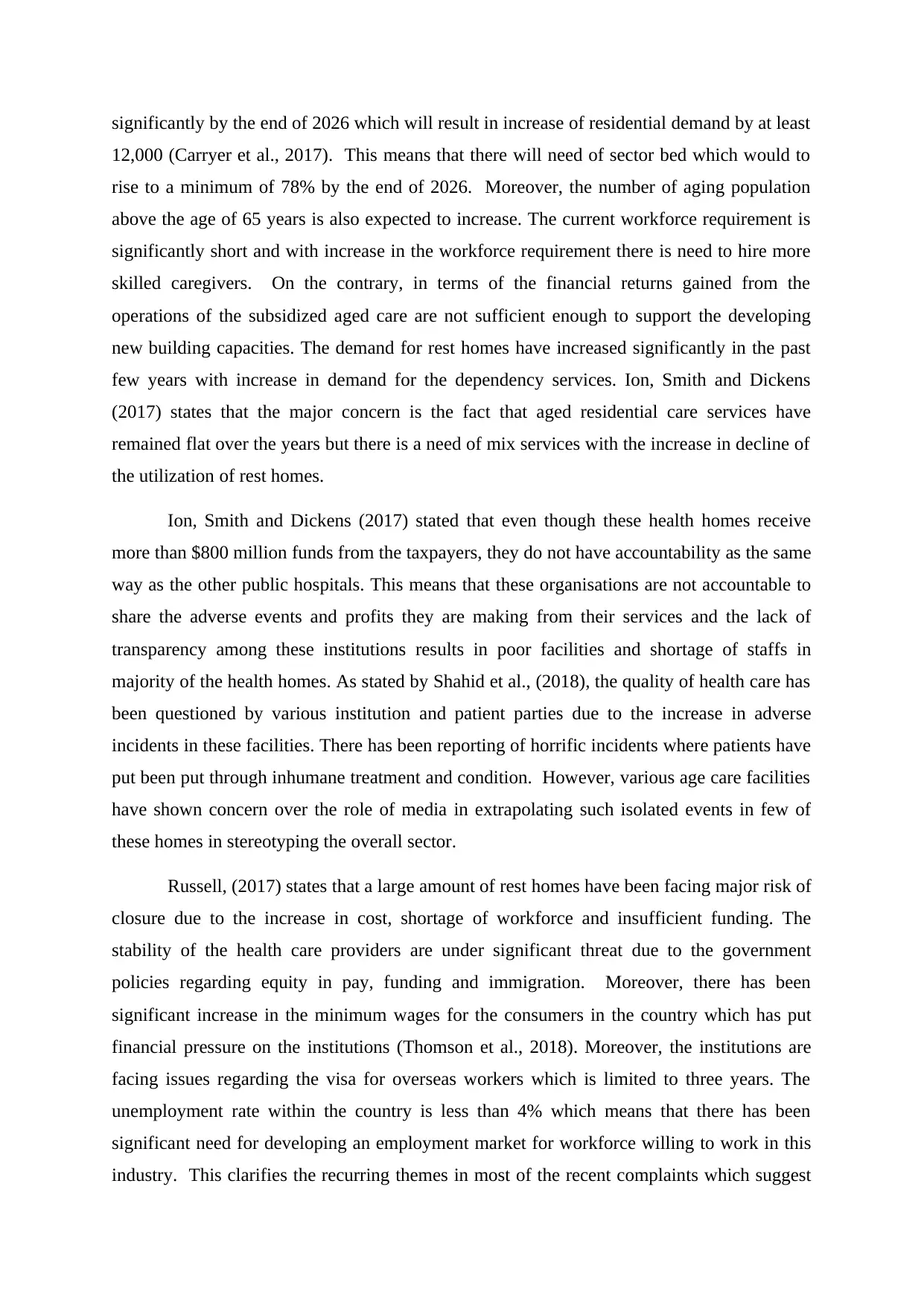
significantly by the end of 2026 which will result in increase of residential demand by at least
12,000 (Carryer et al., 2017). This means that there will need of sector bed which would to
rise to a minimum of 78% by the end of 2026. Moreover, the number of aging population
above the age of 65 years is also expected to increase. The current workforce requirement is
significantly short and with increase in the workforce requirement there is need to hire more
skilled caregivers. On the contrary, in terms of the financial returns gained from the
operations of the subsidized aged care are not sufficient enough to support the developing
new building capacities. The demand for rest homes have increased significantly in the past
few years with increase in demand for the dependency services. Ion, Smith and Dickens
(2017) states that the major concern is the fact that aged residential care services have
remained flat over the years but there is a need of mix services with the increase in decline of
the utilization of rest homes.
Ion, Smith and Dickens (2017) stated that even though these health homes receive
more than $800 million funds from the taxpayers, they do not have accountability as the same
way as the other public hospitals. This means that these organisations are not accountable to
share the adverse events and profits they are making from their services and the lack of
transparency among these institutions results in poor facilities and shortage of staffs in
majority of the health homes. As stated by Shahid et al., (2018), the quality of health care has
been questioned by various institution and patient parties due to the increase in adverse
incidents in these facilities. There has been reporting of horrific incidents where patients have
put been put through inhumane treatment and condition. However, various age care facilities
have shown concern over the role of media in extrapolating such isolated events in few of
these homes in stereotyping the overall sector.
Russell, (2017) states that a large amount of rest homes have been facing major risk of
closure due to the increase in cost, shortage of workforce and insufficient funding. The
stability of the health care providers are under significant threat due to the government
policies regarding equity in pay, funding and immigration. Moreover, there has been
significant increase in the minimum wages for the consumers in the country which has put
financial pressure on the institutions (Thomson et al., 2018). Moreover, the institutions are
facing issues regarding the visa for overseas workers which is limited to three years. The
unemployment rate within the country is less than 4% which means that there has been
significant need for developing an employment market for workforce willing to work in this
industry. This clarifies the recurring themes in most of the recent complaints which suggest
12,000 (Carryer et al., 2017). This means that there will need of sector bed which would to
rise to a minimum of 78% by the end of 2026. Moreover, the number of aging population
above the age of 65 years is also expected to increase. The current workforce requirement is
significantly short and with increase in the workforce requirement there is need to hire more
skilled caregivers. On the contrary, in terms of the financial returns gained from the
operations of the subsidized aged care are not sufficient enough to support the developing
new building capacities. The demand for rest homes have increased significantly in the past
few years with increase in demand for the dependency services. Ion, Smith and Dickens
(2017) states that the major concern is the fact that aged residential care services have
remained flat over the years but there is a need of mix services with the increase in decline of
the utilization of rest homes.
Ion, Smith and Dickens (2017) stated that even though these health homes receive
more than $800 million funds from the taxpayers, they do not have accountability as the same
way as the other public hospitals. This means that these organisations are not accountable to
share the adverse events and profits they are making from their services and the lack of
transparency among these institutions results in poor facilities and shortage of staffs in
majority of the health homes. As stated by Shahid et al., (2018), the quality of health care has
been questioned by various institution and patient parties due to the increase in adverse
incidents in these facilities. There has been reporting of horrific incidents where patients have
put been put through inhumane treatment and condition. However, various age care facilities
have shown concern over the role of media in extrapolating such isolated events in few of
these homes in stereotyping the overall sector.
Russell, (2017) states that a large amount of rest homes have been facing major risk of
closure due to the increase in cost, shortage of workforce and insufficient funding. The
stability of the health care providers are under significant threat due to the government
policies regarding equity in pay, funding and immigration. Moreover, there has been
significant increase in the minimum wages for the consumers in the country which has put
financial pressure on the institutions (Thomson et al., 2018). Moreover, the institutions are
facing issues regarding the visa for overseas workers which is limited to three years. The
unemployment rate within the country is less than 4% which means that there has been
significant need for developing an employment market for workforce willing to work in this
industry. This clarifies the recurring themes in most of the recent complaints which suggest
⊘ This is a preview!⊘
Do you want full access?
Subscribe today to unlock all pages.

Trusted by 1+ million students worldwide
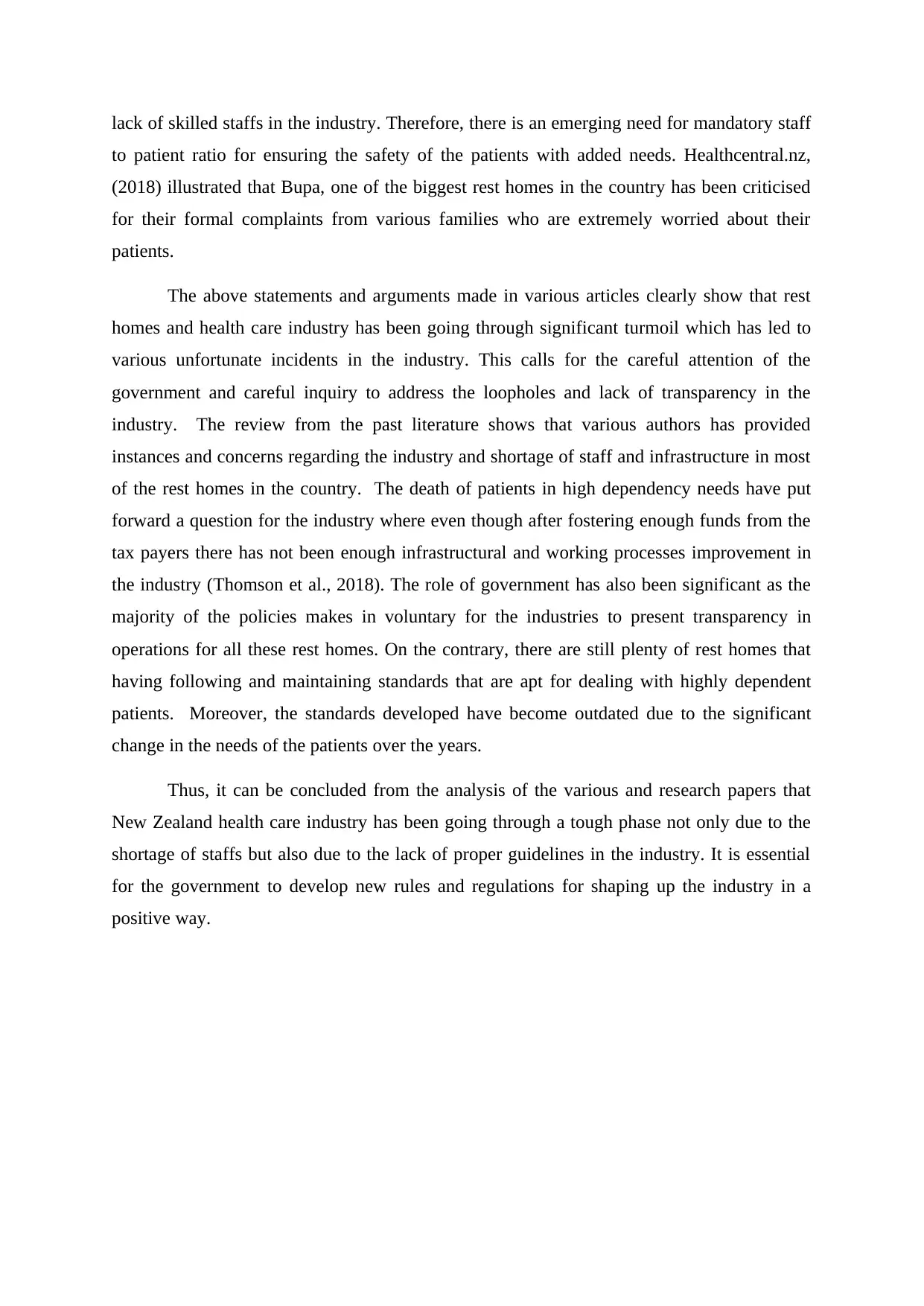
lack of skilled staffs in the industry. Therefore, there is an emerging need for mandatory staff
to patient ratio for ensuring the safety of the patients with added needs. Healthcentral.nz,
(2018) illustrated that Bupa, one of the biggest rest homes in the country has been criticised
for their formal complaints from various families who are extremely worried about their
patients.
The above statements and arguments made in various articles clearly show that rest
homes and health care industry has been going through significant turmoil which has led to
various unfortunate incidents in the industry. This calls for the careful attention of the
government and careful inquiry to address the loopholes and lack of transparency in the
industry. The review from the past literature shows that various authors has provided
instances and concerns regarding the industry and shortage of staff and infrastructure in most
of the rest homes in the country. The death of patients in high dependency needs have put
forward a question for the industry where even though after fostering enough funds from the
tax payers there has not been enough infrastructural and working processes improvement in
the industry (Thomson et al., 2018). The role of government has also been significant as the
majority of the policies makes in voluntary for the industries to present transparency in
operations for all these rest homes. On the contrary, there are still plenty of rest homes that
having following and maintaining standards that are apt for dealing with highly dependent
patients. Moreover, the standards developed have become outdated due to the significant
change in the needs of the patients over the years.
Thus, it can be concluded from the analysis of the various and research papers that
New Zealand health care industry has been going through a tough phase not only due to the
shortage of staffs but also due to the lack of proper guidelines in the industry. It is essential
for the government to develop new rules and regulations for shaping up the industry in a
positive way.
to patient ratio for ensuring the safety of the patients with added needs. Healthcentral.nz,
(2018) illustrated that Bupa, one of the biggest rest homes in the country has been criticised
for their formal complaints from various families who are extremely worried about their
patients.
The above statements and arguments made in various articles clearly show that rest
homes and health care industry has been going through significant turmoil which has led to
various unfortunate incidents in the industry. This calls for the careful attention of the
government and careful inquiry to address the loopholes and lack of transparency in the
industry. The review from the past literature shows that various authors has provided
instances and concerns regarding the industry and shortage of staff and infrastructure in most
of the rest homes in the country. The death of patients in high dependency needs have put
forward a question for the industry where even though after fostering enough funds from the
tax payers there has not been enough infrastructural and working processes improvement in
the industry (Thomson et al., 2018). The role of government has also been significant as the
majority of the policies makes in voluntary for the industries to present transparency in
operations for all these rest homes. On the contrary, there are still plenty of rest homes that
having following and maintaining standards that are apt for dealing with highly dependent
patients. Moreover, the standards developed have become outdated due to the significant
change in the needs of the patients over the years.
Thus, it can be concluded from the analysis of the various and research papers that
New Zealand health care industry has been going through a tough phase not only due to the
shortage of staffs but also due to the lack of proper guidelines in the industry. It is essential
for the government to develop new rules and regulations for shaping up the industry in a
positive way.
Paraphrase This Document
Need a fresh take? Get an instant paraphrase of this document with our AI Paraphraser
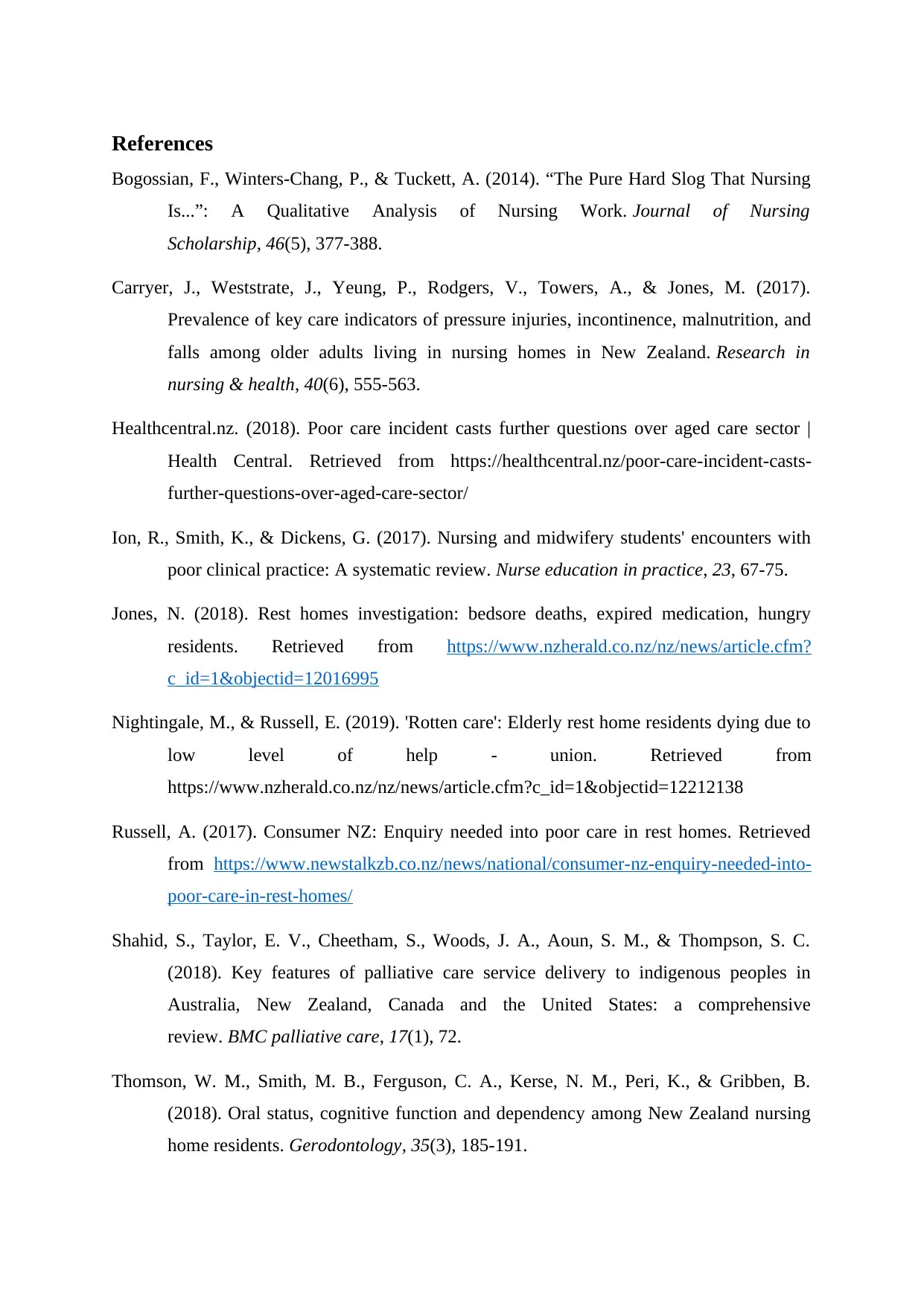
References
Bogossian, F., Winters‐Chang, P., & Tuckett, A. (2014). “The Pure Hard Slog That Nursing
Is...”: A Qualitative Analysis of Nursing Work. Journal of Nursing
Scholarship, 46(5), 377-388.
Carryer, J., Weststrate, J., Yeung, P., Rodgers, V., Towers, A., & Jones, M. (2017).
Prevalence of key care indicators of pressure injuries, incontinence, malnutrition, and
falls among older adults living in nursing homes in New Zealand. Research in
nursing & health, 40(6), 555-563.
Healthcentral.nz. (2018). Poor care incident casts further questions over aged care sector |
Health Central. Retrieved from https://healthcentral.nz/poor-care-incident-casts-
further-questions-over-aged-care-sector/
Ion, R., Smith, K., & Dickens, G. (2017). Nursing and midwifery students' encounters with
poor clinical practice: A systematic review. Nurse education in practice, 23, 67-75.
Jones, N. (2018). Rest homes investigation: bedsore deaths, expired medication, hungry
residents. Retrieved from https://www.nzherald.co.nz/nz/news/article.cfm?
c_id=1&objectid=12016995
Nightingale, M., & Russell, E. (2019). 'Rotten care': Elderly rest home residents dying due to
low level of help - union. Retrieved from
https://www.nzherald.co.nz/nz/news/article.cfm?c_id=1&objectid=12212138
Russell, A. (2017). Consumer NZ: Enquiry needed into poor care in rest homes. Retrieved
from https://www.newstalkzb.co.nz/news/national/consumer-nz-enquiry-needed-into-
poor-care-in-rest-homes/
Shahid, S., Taylor, E. V., Cheetham, S., Woods, J. A., Aoun, S. M., & Thompson, S. C.
(2018). Key features of palliative care service delivery to indigenous peoples in
Australia, New Zealand, Canada and the United States: a comprehensive
review. BMC palliative care, 17(1), 72.
Thomson, W. M., Smith, M. B., Ferguson, C. A., Kerse, N. M., Peri, K., & Gribben, B.
(2018). Oral status, cognitive function and dependency among New Zealand nursing
home residents. Gerodontology, 35(3), 185-191.
Bogossian, F., Winters‐Chang, P., & Tuckett, A. (2014). “The Pure Hard Slog That Nursing
Is...”: A Qualitative Analysis of Nursing Work. Journal of Nursing
Scholarship, 46(5), 377-388.
Carryer, J., Weststrate, J., Yeung, P., Rodgers, V., Towers, A., & Jones, M. (2017).
Prevalence of key care indicators of pressure injuries, incontinence, malnutrition, and
falls among older adults living in nursing homes in New Zealand. Research in
nursing & health, 40(6), 555-563.
Healthcentral.nz. (2018). Poor care incident casts further questions over aged care sector |
Health Central. Retrieved from https://healthcentral.nz/poor-care-incident-casts-
further-questions-over-aged-care-sector/
Ion, R., Smith, K., & Dickens, G. (2017). Nursing and midwifery students' encounters with
poor clinical practice: A systematic review. Nurse education in practice, 23, 67-75.
Jones, N. (2018). Rest homes investigation: bedsore deaths, expired medication, hungry
residents. Retrieved from https://www.nzherald.co.nz/nz/news/article.cfm?
c_id=1&objectid=12016995
Nightingale, M., & Russell, E. (2019). 'Rotten care': Elderly rest home residents dying due to
low level of help - union. Retrieved from
https://www.nzherald.co.nz/nz/news/article.cfm?c_id=1&objectid=12212138
Russell, A. (2017). Consumer NZ: Enquiry needed into poor care in rest homes. Retrieved
from https://www.newstalkzb.co.nz/news/national/consumer-nz-enquiry-needed-into-
poor-care-in-rest-homes/
Shahid, S., Taylor, E. V., Cheetham, S., Woods, J. A., Aoun, S. M., & Thompson, S. C.
(2018). Key features of palliative care service delivery to indigenous peoples in
Australia, New Zealand, Canada and the United States: a comprehensive
review. BMC palliative care, 17(1), 72.
Thomson, W. M., Smith, M. B., Ferguson, C. A., Kerse, N. M., Peri, K., & Gribben, B.
(2018). Oral status, cognitive function and dependency among New Zealand nursing
home residents. Gerodontology, 35(3), 185-191.
1 out of 5
Related Documents
Your All-in-One AI-Powered Toolkit for Academic Success.
+13062052269
info@desklib.com
Available 24*7 on WhatsApp / Email
![[object Object]](/_next/static/media/star-bottom.7253800d.svg)
Unlock your academic potential
Copyright © 2020–2025 A2Z Services. All Rights Reserved. Developed and managed by ZUCOL.




